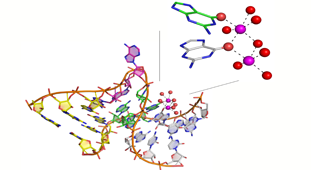Putting a kink into the cell's key genetic molecule
Published On Wed 29 Oct 2014 by Roddy Isles

Scientists at the University of Dundee have discovered a hidden `code’ that tells our bodies key genetic molecules how to structure themselves, thereby allowing them to carry out their work.
In a research paper published in the journal Nature Communications, Professor David Lilley and colleagues describe how a crucial part of RNA called the `kink-turn’ operates.
Professor David Lilley and colleagues in the College of Life Sciences at Dundee have been studying the function of RNA, the molecules that play a significant role in almost every genetic function of our cells.
RNA is chemically similar to DNA. It is synthesized as a long chain of components, but in order to carry out its myriad functions it must fold up into complex three-dimensional structures.
Professor Lilley said, “Understanding this folding process is a great challenge, but it can be simplified by noting that there are underlying 'nuts and bolts' that hold the folded molecule together.
“One of these is called the `kink-turn’, which acts like an angle bracket to introduce a very sharp turn into the structure, so bringing important parts of the molecule together. These key structural elements are very widespread, and are found in the molecular machines that make proteins, process RNA into its mature form, and switch genes on and off.
“We have now discovered that buried within the kink-turn is a hidden code that tells the RNA how to fold. This has allowed us to establish a set of rules that can be used to predict the folding characteristics of kink-turns if their sequence composition is known.
“We have found that different classes of RNA molecules have different code elements conferring different folding behaviour, each suited to their biological function.
“Moreover, we can now provide a chemical explanation of how the code works.”
By determining the structure of a kink-turn molecule using X-rays, Professor Lilley and colleagues found that atoms of a metal were attached at the element that codes folding behaviour. The ability to bind, or not, these metal atoms determines the folding character of the RNA, and therefore its function in the cell.
NOTES TO EDITORS
Life Sciences at Dundee
With more than 900 scientists, research students and support staff from 62 countries and external funding in excess of £50million per annum, the College of Life Sciences at the University of Dundee is one of the largest and most productive Life Sciences research institutes in Europe. The College has an international reputation for its basic and translational research and was recognised in the 2011 Biotechnology and Biological Sciences Research Council Excellence with Impact Awards for 'Greatest Delivery of Impact'. The University of Dundee is the central hub for a multi-million pound biotechnology sector in the east of Scotland, which now accounts for 16% of the local economy. www.dundee.ac.uk
Roddy Isles
Head of Press
TEL: 01382 384910
MOBILE: 07800 581902
E-MAIL: r.isles@dundee.ac.uk